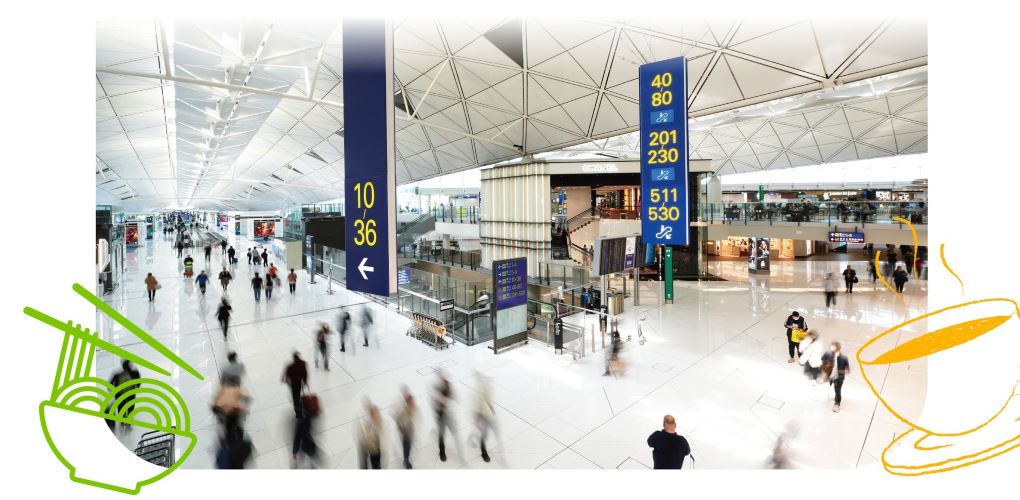UK. Outdoor advertising market leader JCDecaux today hosted an immersive presentation titled ‘The Future is Flight’ at The Gherkin, London to highlight insights from its latest research: First Class Advertising – The Enduring Magic of Airports.
A discussion of Heathrow Airport’s post-pandemic recovery and growth outlook was a key highlight at the event, seen through the lens of airport advertising. During opening remarks, JCDecaux UK Director of Airports David Hawkins said: “We were done with the COVID-19 aftermath in 2023. This morning we’re not talking about recovery; we’re talking about growth.”

Guest speaker Heathrow Retail Director Fraser Brown kicked off the presentations with a slideshow titled ‘Heathrow – Your Future Airport Advertising Partner’.
He said: “This March was the busiest march we’ve had in our 78-year history. We just had our biggest Easter, and 2024 will be our biggest year yet.

“We’ve got businesses in the airport that are trading retail volume views per second at numbers that we’ve never seen in their history either.”
Brown mentioned that Heathrow is the fourth largest airport in the world and it tops the list in connecting people to most destinations.

In the last 18 months, over 20 high-end luxury stores have opened at the airport. “These brands are confident that Heathrow is the right place for them, not just to reach over 83 million passengers, but equally to trade and sell. It’s an important part of our retail mix.
“We obviously also do standalone pop-up experiences, giving brands fantastic, unique canvases to showcase what they’re doing.”
Diving into the research

Brown’s address was followed by a presentation titled ‘The Future is Flight – The Research’ by JCDecaux UK Acting Head of Marketing – Agency & Partner Elena Karoussis and Head of Sales, Airport – Agencies & Clients Alex Russell.
Together they delved into the methodology that went into collecting data for First Class Advertising – The Enduring Magic of Airports.
As reported, the study carried out by Ipsos provides an updated perspective on air passenger profiles, their relationship with the airport environment and their perception of advertising within airports.
The surveys were conducted across 14 countries with 11,368 online respondents and 9,470 flyers. An additional survey for the UK recorded 800 online respondents of which 600 have visited Heathrow Airport.
Karoussis said: “This has been useful to give us extra intel into the domestic Heathrow passengers at a terminal level.”
Russell added: “When do consumers want to travel? We have international sporting events coming up, so we are really incentivising short haul travel.
“The economy is in a better place than it was a year ago. Inflation has fallen to 3.4% and interest and exchange rates have also stabilised. So simply said, the future is indeed bright.”
“We know that in 2023 there were 8. 6 billion passengers globally, which is 95% of 2019 levels.
“And now in 2024 the forecast is for 9.7 million passengers, which is 106% of 2019 levels. The outlook continues to be positive, with +30% more global passenger traffic by 2027 versus 2019.”
Russell also addressed the growing concern for sustainability in aviation. She said: “We’re aware of the increased concerns over the ecological cost of air travel and the fact that many people do indeed want to minimise their carbon footprint.”

Brown shed light on how Heathrow Airport cuts emissions: “Sustainable aviation fuels are our most important way to decarbonise flying. By 2030, our goal is that carbon from flights falls -15% from 2019 levels.
“Heathrow landing charges also encourage airlines to use the cleanest and quietest aircrafts possible.”
Gen Z aka ‘the future of air travel’
Russell introduced four types of travel retail consumers: business flyers, frequent flyers, high airport spenders and Gen Z. She said: “We have identified these four groups because we feel they align with how our advertisers think about their audiences.

“The group I want to focus our attention on today is the Gen Z flyer. They represent 18% of the Heathrow audience, but let’s face it, they also represent the future of air travel.
“Gen Z flyers at Heathrow represent 43% of the business flyers, 25% of frequent flyers and 19% of high airport spenders. I should also point out that 21% of them are actually high net worth and they’re earning at least £55,000 a year.

“They’re a valuable and significant audience for airport advertising. Social media platforms such as TikTok and Instagram are very much a part of this generation when it comes to lifestyle inspiration.
“And let’s not forget the power of influencer marketing. It’s a real guiding force behind this generation’s travel planning.”
According to the JCDecaux report, while Gen Z passengers are digital natives, they are looking to reduce their online media consumption through in-person entertainment.

The airport advertising experience
JCDecaux compares the perception of advertising online and through social media in First Class Advertising – The Enduring Magic of Airports.
Russell remarked: “UK flies airport advertising more favourably than online and social media across the metrics of international status, creativity, superior quality, brand image and attention.
“Heathrow’s passengers are making the time to savour the airport experience. Our UK additional research enables us to quantify what they are doing during their average 89 minutes. This doesn’t include any time spent on check-in or security.

“Using state-of-the-art tracking technology and a media-first approach, we saw how digitalised phone advertising, mobile advertising and exposure to both mediums increase attention and subsequent impact for advertising on people.”
“Advertising is positively welcomed by travellers and the magic of airports is very much alive. Travellers view the environment as special, and shopping is a typical part of the journey, with a majority spending money at the airport.”
Click on the video for the full Heathrow T2 tour with Retail Director Fraser Brown and The Moodie Davitt Report President Dermot Davitt, filmed earlier this year.
Hawkins brought the event to a close with an overview of targeted advertising. He said: “We have this treasure trove of information available to help brands and agencies plan effective airport campaigns.
“We are privileged to have access to real-time data. We can see who’s in the airport, what they’re doing, where they’re going and track them as they go through the airport process.

“That kind of exact data is really fueling the industry’s adoption of programmatic campaigns.
“The ability to use these triggers and data to target and automate advertising helps influence the right audience at the right time and with the right mindset.” ✈











